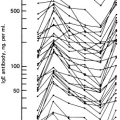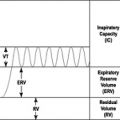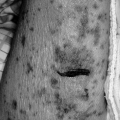Nasal Polyposis, Sinusitis, and Nonallergic Rhinitis
Tolly G. Epstein
David I. Bernstein
Nasal Polyps
Nasal polyps (NPs) have been recognized and treated since ancient times. The occurrence of nasal polyps in association with asthma and aspirin sensitivity, otherwise known as the aspirin triad, was first identified in 1911 (1). NPs are associated with chronic mucosal inflammation; a condition often referred to as chronic hyperplastic rhinosinusitis. In most cases, NPs arise from the mucosa of the middle meatus and clefts of the ethmoid region (2,3). Polyp tissue is generally characterized by chronic eosinophilic infiltration, but plasma cells, lymphocytes, and mast cells are also typically present (4,5). Polypoid tissue is rich in ground substance containing acid mucopolysaccharide (6).
The prevalence of nasal polyposis in the general population is estimated at 2% to 4% (7,8). A recent large population based study did not reveal any gender differences (9). NPs are diagnosed more often during the third and fourth decades of life. Most clinical data indicate that there is no greater prevalence of nasal polyps among atopic compared with normal populations, however, the coexistence of allergic rhinitis may render symptom control more challenging (10,11). In a study of an adult allergy clinic population, 4.2% of patients had NPs; 71% of polyp patients had asthma; and 14% had aspirin intolerance (12). NPs are less common in children. The discovery of NPs in a child should prompt an evaluation for cystic fibrosis (CF), in which the prevalence of NPs is 6.7% to 46%. NPs are also reported to affect 37% of adults with CF (13).
Clinical Presentation
Patients with nasal polyposis present with perennial nasal congestion, rhinorrhea, and anosmia (or hypos-mia). Nasal and osteomeatal obstruction may result in purulent nasal discharge and chronic sinusitis. Enlargement of NPs may lead to broadening of the nasal bridge, and rarely, encroachment into the orbit, resulting in compression of ocular structures and unilateral proptosis, falsely suggesting an orbital malignancy (14).
A thorough examination with a nasal speculum is necessary for identification of NPs. More complete visualization can be accomplished by flexible rhinoscopy. NPs appear as bulbous translucent to opaque growths, often extending from the middle and inferior nasal turbinates, causing partial or complete obstruction of the nasal canals. Frontal, ethmoidal, and maxillary tenderness with purulent nasal discharge from the middle meatus indicate concurrent acute or chronic paranasal sinusitis. Sinus radiographic studies are rarely needed to identify NPs. Common radiographic changes include widening of the ethmoid labyrinths; mucoceles or pyoceles within the paranasal sinuses; and generalized loss of translucence in the maxillary, ethmoid, and frontal sinuses (15).
Etiology
While multiple theories regarding the etiology of nasal polyposis have been proposed, the pathogenesis remains poorly defined. Allergic mechanisms have been investigated, but no consistent association has been established between atopy and nasal polyposis. Patients with NPs are less likely to be sensitized to perennial allergens than those diagnosed with allergic rhinitis (16). Mast cells and mast cell mediators are abundant in polyp tissue and eosinophils are present in 70% to 90% of cases (4). CD8+ T cells are increased in polyp tissue when compared with healthy controls (17). Immunoglobulin G (IgG), IgM, IgA, and IgE levels are also elevated in polyp fluid (18).
Growth factors and cytokines that can stimulate in vitro proliferation of basophils, mast cells, and eosinophils are present in NP tissue (19). The potential roles of TH1 (T-helper cell type 1) and TH2 (T-helper cell type 2) cytokines are under investigation (20). Total IgE and IL-5 levels are higher in nasal tissue of patients
having chronic rhinosinusitis (CRS) with nasal polyps (CRSwNP), compared with CRS patients without NP (CRSsNP) (21). The pathophysiology of CF-related polyp disease may be different from that of non-CF-related polyps. For example, myeloperoxidase and IL-8 are increased in polyp tissue from CF patients, whereas ECP, eotaxin, and IgE are elevated in NPs of patients without CF (22).
having chronic rhinosinusitis (CRS) with nasal polyps (CRSwNP), compared with CRS patients without NP (CRSsNP) (21). The pathophysiology of CF-related polyp disease may be different from that of non-CF-related polyps. For example, myeloperoxidase and IL-8 are increased in polyp tissue from CF patients, whereas ECP, eotaxin, and IgE are elevated in NPs of patients without CF (22).
Microbial pathogens have been postulated to play a role in the pathogenesis of NPs by promoting inflammation. In particular, Staphylococcus aureus-derived toxins may act as conventional allergens, leading to production of specific IgE, or as superantigens that can nonspecifically activate T cells (23). Patou et al. showed that Staph-derived protein A induces mast cell degranulation, while enterotoxin B can induce release of TH2 cytokines, including IL-4, IL-5, and IL-13, and the regulatory cytokine, IL-10 in nasal polyp tissue (24).
The role of oxidative stress has also been investigated. Free oxygen radicals have been identified in NP tissue. Increased severity of nasal polyposis and bronchial hyperresponsiveness correlate with levels of free oxygen radicals in polyp tissue (25).
Aspirin intolerance is generally associated with severe nasal polyposis and chronic sinusitis that is less responsive to treatment (26). The link between aspirin sensitivity, asthma, and NPs has been attributed to enhanced production of leukotrienes from arachidonic acid. Patients with nasal polyposis generally have elevated levels of urinary LTE4 at baseline (27). Aspirin-sensitive patients demonstrate increased levels of urinary leukotriene E4 (LTE4) after oral aspirin challenge (28). In addition, LTC4 synthase is overexpressed in NPs of patients with aspirin exacerbated respiratory disease (AERD)(29).
Treatment
Intranasal glucocorticoids are the treatment of choice for nasal polyposis and are often more effective than surgical polypectomy; intranasal steroids significantly reduce polyp size, nasal congestion, rhinorrhea, and increase nasal airflow (30, 31). Aggressive treatment of NPs with intranasal corticosteroids has also been reported to reduce the need for surgery (32). The effectiveness of intranasal steroids on improving olfactory dysfunction is variable; the best results may be obtained using a short course of oral corticosteroids (30 mg to 35 mg of prednisone daily for 5 to 7 days) followed by maintenance therapy with intranasal steroids (33,34). Optimal delivery of intranasal steroids is achieved by positioning the head in the downward and forward position. Higher doses of intranasal corticosteroids may be more effective. Coexistent sinus infections, which may reduce responsiveness to intranasal steroids, should be treated appropriately.
Limited data exist regarding the use of leukotriene antagonists to treat nasal polyposis. In a double-blind study of 40 post-operative patients with nasal polyps, there was no difference in the recurrence rate of polyps between patients treated with montelukast versus nasal beclomethasone for 1 year (35). However, intranasal steroids exhibited superiority in treating olfactory deficits and nasal congestion. Another small, double-blind study found significant improvement in health-related-quality-of-life in polyps patients on montelukast versus placebo for 4 weeks (36). Larger, controlled trials are needed to assess the usefulness and comparative efficacy (i.e., montelukast versus zileuton) of these drugs in treating NPs.
Surgical treatment for nasal polyposis should be considered when optimal medical therapy has failed. Simple polypectomy may be indicated for complete nasal obstruction, which causes extreme discomfort. If NPs are associated with persistent ethmoid sinusitis with obstruction of the osteomeatal complex, a more extensive surgical procedure may be considered. Several randomized controlled trials have shown equivalent outcomes at 1 year of follow-up after surgical versus medical management of NPs (37,38). Nasal polyps frequently recur after simple surgical polypectomy, and long-term recurrence rates may be as high as 60% following functional endoscopic sinus surgery (FESS) for severe disease (39). While further studies evaluating the role of long-term nasal steroids after surgery are needed, their administration in this setting should be considered to prevent recurrence (40).
Outcomes of FESS are generally less favorable among AERD patients compared with patients with chronic sinusitis who are aspirin-insensitive (41). In a retrospective study, patients with AERD had more extensive sinus disease based on radiologic findings, and 39% required surgical revisions versus 9% of sinusitis patients without aspirin sensitivity (41). The addition of aspirin following surgery may improve long-term outcomes in selected patients with nasal polyposis and AERD (42). Long-term aspirin desensitization has been reported to reduce the number of episodes of acute sinusitis, corticosteroid use, and requirement for polypectomies and sinus surgery (43). Because of the risk of provoking severe asthmatic attacks, this procedure should be performed exclusively by an experienced practitioner in an appropriate setting, and considered only in aspirin-sensitive patients refractory to conventional therapies (44).
Sinusitis
Sinusitis affects approximately 16% of the population (45). The estimated annual health care costs for sinusitis exceed $3.5 billion annually, not including the costs incurred by missed work days (45). Sinusitis is an inflammatory disorder of the mucosal lining of the paranasal sinuses that may be initiated by infectious or noninfectious factors. Viral upper respiratory infections
often precede acute bacterial sinus infections. Given that most viral infections resolve within 7 to 10 days, acute bacterial sinusitis is typically diagnosed when symptoms persist beyond 7 days (46). Rhinosinusitis is referred to as chronic when it persists for more than 8 to 12 weeks (47). Noninfectious triggers for sinusitis include environmental exposures to fumes or chemical vapors. Bacterial sinusitis has long been considered a complication of seasonal or perennial allergic rhinitis (48,49). Individuals with exposure to tobacco smoke and those with nonallergic rhinitis are also more susceptible to recurrent or chronic sinusitis (50,51).
often precede acute bacterial sinus infections. Given that most viral infections resolve within 7 to 10 days, acute bacterial sinusitis is typically diagnosed when symptoms persist beyond 7 days (46). Rhinosinusitis is referred to as chronic when it persists for more than 8 to 12 weeks (47). Noninfectious triggers for sinusitis include environmental exposures to fumes or chemical vapors. Bacterial sinusitis has long been considered a complication of seasonal or perennial allergic rhinitis (48,49). Individuals with exposure to tobacco smoke and those with nonallergic rhinitis are also more susceptible to recurrent or chronic sinusitis (50,51).
Regardless of initiating events, the four physiologic derangements that contribute to the evolution of infectious sinusitis are: (a) reduced patency of the sinus ostia; (b) a decrease in the partial pressure of oxygen within the sinus cavities; (c) diminished mucociliary transport; and (d) compromise of microcirculation blood flow in the mucosa (52). Edematous obstruction of the sinus ostia is a consistent finding in both acute and chronic sinusitis; this condition causes a low-oxygen environment within the sinus cavity, which results in decreased mucociliary transport and favors the growth of common bacterial pathogens, including Streptococcus pneumoniae, Haemophilus influenzae, and anaerobic bacteria (53).
Biopsies of sinus mucosa from patients with purulent, nonpurulent, and recurrent sinusitis reveal basement membrane thickening, atypical gland formation, goblet cell hyperplasia, inflammatory cell infiltration, and subepithelial edema (52). Increasing chronicity of disease is associated with greater basement membrane thickening and an increase in the number and size of secretory glands (54). Neutrophils are elevated in the sinus fluid of patients with CRS, and IL-8, a strong chemoattractant for neutrophils is elevated in the mucosa of patients with acute sinusitis (19). Other inflammatory cells including eosinophils can also be found; however, these are more prominently associated with accompanying nasal polyposis (55).
Causative Microorganisms
Microbial pathogens implicated in acute maxillary sinusitis have been studied extensively. Identification of bacterial pathogens by endoscopically directed middle meatal cultures closely approximates results obtained via needle puncture of the maxillary sinus (56). However, cultures obtained by nasopharygeal swab do not reflect bacterial isolates in the sinuses. A meta-analysis of cultures obtained by middle meatal sampling or maxillary sinus puncture for acute bacterial sinusitis in adults from 1990 to 2006 revealed that the most common pathogens were: Streptococcus pneumoniae (32.7%), Haemophilus influenzae (31.6%), Staphylococcus aureus (10.1%), and Moraxella catarrhalis (8.8%) (57). Another study, conducted in 1992, of 339 adult patients with acute sinusitis found that viruses were cultured from 8% of aspirates, whereas 15% to 40% of antral aspirates were sterile. Common isolates included rhinovirus, influenza type A, and parainfluenza viruses (58). With the advent of molecular techniques, detectable viruses during sinusitis exceed 50% and include rhinovirus (18%), RSV (15%), adenovirus (3%), and enterovirus (3%) (59).
In children with acute maxillary sinusitis, S. pneumoniae, H. influenzae, and M. catarrhalis have been identified as the predominant pathogens; since the advent of Prevnar, the 7-valent pneumococcal vaccine, the proportion of sinusitis caused by S. pneumoniae has declined, while that caused by H. influenzae has increased (60).
Microbial pathogens involved in CRS may be quite different from those involved in acute disease. Anaerobic bacteria play a large role in CRS in adults, but are rarely identified in children. One series found that 88% of antral aspirates of adult patients with CRS were positive for anaerobes. Predominant aerobic pathogens include S. pneumoniae and S. aureus. There is also increasing concern for drug resistant gram-negative organisms in CRS, particularly Pseudomonas aeruginosa (56,57).
Immunocompromised individuals may develop sinusitis involving unusual or opportunistic organisms. A full discussion is beyond the scope of this text (61). Molecular techniques have revolutionized the rapidity with which diagnoses can be made (62). Mucormycotic sinusitis is caused by fungi of the family Mucoraceae (Mucor), which are zygomycetes. These organisms are saprophytic, abundant in the natural environment, and may be isolated from the throat and stools of normal individuals. Mucormycotic sinusitis is potentially fatal in diabetic, leukemic, or otherwise immunosuppressed patients. Similarly, invasive aspergillosis may involve the paranasal sinuses, primarily in the immunocompromised host, with rare cases occurring in immunocompetant individuals. Invasive aspergillosis involving the sphenoid sinus is particularly difficult to treat, even in immunocompetant patients, and can result in severe neurologic complications (63). Rarely, tuberculosis can cause infectious sinusitis, particularly in immunocompromised patients. Atypical mycobacteria have been reported to cause sinusitis in patients with acquired immunodeficiency syndrome (64).
Allergic fungal sinusitis is an increasingly recognized syndrome occurring in immunocompetant atopic patients with hypertrophic rhinitis and NPs, which may result from local hypersensitivity responses to a variety of mold spores colonizing the sinus cavities. Abundant mucin found within the sinuses demonstrates numerous eosinophils and Charcot-Leyden crystals; fungal stains reveal the presence of noninvasive hyphae (65). The disease occurs primarily in adults, but should be considered in atopic children with refractory sinus disease (66). While Aspergillus species are frequently involved,
dematiaceous fungi have also been implicated. Patients generally exhibit high total serum IgE levels and have positive skin tests to fungal allergens (65).
dematiaceous fungi have also been implicated. Patients generally exhibit high total serum IgE levels and have positive skin tests to fungal allergens (65).
Clinical Presentation
Episodes of acute sinusitis are most commonly preceded by symptoms suggestive of viral upper respiratory tract infections or other environmental stimuli, which can cause mucosal inflammation, hypertrophy, and obstruction of the sinus ostia. Common presenting symptoms include frontal or maxillary head pain, fever, and mucopurulent or bloody nasal discharge. Other clinical features include general malaise, cough, hypos-mia, mastication pain, and changes in the resonance of speech. Pain cited as coming from the upper molars may represent an early symptom of acute maxillary sinusitis. Children with acute maxillary sinusitis present most often with cough, nasal discharge, and fetid breath, while fever is less common (50).
Symptoms associated with CRS are less fulminant; facial pain and/or pressure, headache, and postnasal discharge are common. The clinician should be aware that chronic maxillary sinusitis may result from primary dental infections (i.e., apical granuloma of the molar teeth, periodontitis) (55). Pain associated with temporomandibular dysfunction may be incorrectly diagnosed as CRS. Individuals with sinusitis may experience severe facial pain associated with rapid changes in position (e.g., lying supine or bending forward) or with rapid changes in atmospheric pressure that occur during air travel.
Stay updated, free articles. Join our Telegram channel

Full access? Get Clinical Tree








